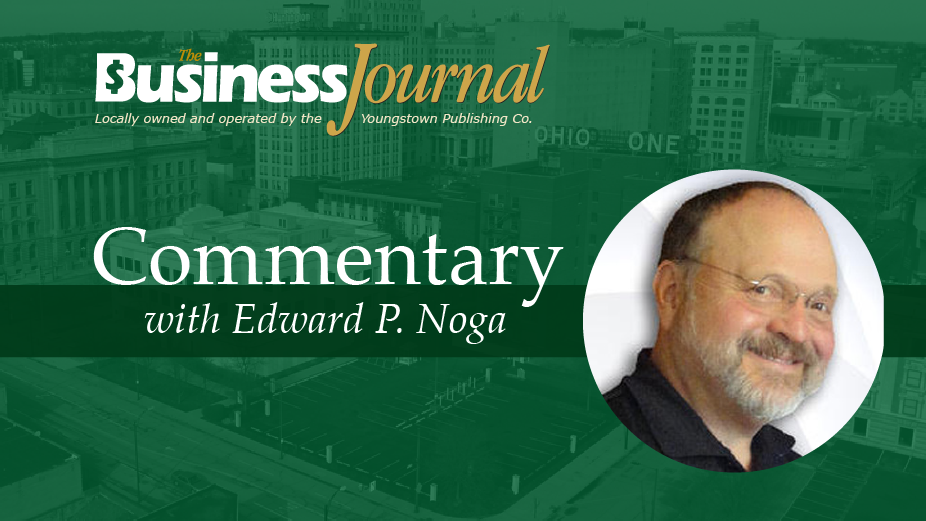By Edward P. Noga
From my younger years, I remember attending Youngstown State University football and basketball games at high school gridirons and gymnasiums. Those were the days before Beeghly Center and Stambaugh Stadium.
And, yes, there were some nail-biters, wild games at places like the Struthers Fieldhouse and Austintown Fitch Stadium. It was the era of YSU basketball standout John McElroy, who scored 52 points one night in South High Fieldhouse and several days later scored 72 points during a game in Detroit.
Actually, in that game he outscored the entire opposing team! John died recently. He still holds many local basketball records.
In those days, it was not uncommon to hear folks say, “Someday we will have our own facilities to accommodate our university’s sports programs. If we only had the money.”
Early on in my time as pastor on the south side of the city, some friends and I regularly jogged across the Market Street Bridge on our way to the YMCA and then to the Mill Creek Park entrance under the Mahoning Avenue Bridge. There were times on the way back and up the Market Street bridge that we slowed down and walked it off.
Occasionally, as we made our way up the bridge, someone said, “You know this area along the river will probably be a lot different someday. Wouldn’t be surprised to see apartments and condos on the hillside along Ridge Avenue on the south side of the river overlooking downtown.”
These comments came long before the Covelli Centre, the Youngstown Foundation Amphitheater and the recent proposal to remove the dam along the river from Warren to south of Youngstown. Such comments would usually be followed by the phrase, “If we just had the investors. If we just had the money.”
We all know that dreams and artist’s renderings and proposals are necessary as communities change. We also know that public and private dollars are a key piece of the puzzle. For almost two years, I have been humbled by the leadership of this publication in giving me the opportunity to reflect on our valley.
My very first essay was based on the movie “A River Runs Through It.” In that column, I mentioned conversations then being held about the Mahoning River that runs through our Valley. The river was part of the magnet that catapulted many communities into steelmaking juggernauts that brought my family and many others here in the early 20th century.
The current pandemic has given new emphasis to the word “unprecedented.” One residual of the virus has been the staggering loss of revenue to businesses, government, charities and families. Local, state and the national governments have begun each day this past year by dealing with yet another ramification of “unprecedented.”
How many times have we witnessed the financial resources drying up? It’s been nothing less than mind-boggling.
Along comes the recent America Rescue Plan that will send millions of dollars into the Mahoning Valley with large amounts going to our two largest cities, Warren and Youngstown. Talk about unprecedented! “If we only had the money” takes on new meaning.
Although I don’t know the perimeters of the spending formula, I do know that this can be a game changer. What a blessing and challenge for community leaders to research, ponder and deliberate the use of these monies.
One might hope that leaders will look to other locales with comparable populations to see how they plan to use the funds. Such inquiries can become a good tool for our local discussions.
In addition, the citizens of the Valley who have contributed millions of dollars in taxes over the years to fund local life should receive a nod in the final appropriations as a way of saying thank you.
For instance, in some way, every resident and visitor makes use of the roads, bridges and sidewalks in our Valley. It might be nice to see local- government councils work on some common corridors, even look beyond, to some common thoroughfares between communities.
The mayors of Warren and Youngstown certainly have community issues in their jurisdictions. They also have a good working relationship with each other that can draw other communities into beneficial discussions about these funds.
Case in point: the Western Reserve Transit Authority covers 216 square miles with over 800 stops a day. A fair number of riders use the bus to get to their jobs and a good many others use the bus system as their primary mode of transportation.
There is no doubt that each of us can come up with our “top five” or “top 10” priorities for such an infusion of much needed investment.
Care, caution and open discussion need to be the order of the day so that, in the end, the monies are spent in truly game changing ways along our Valley.
